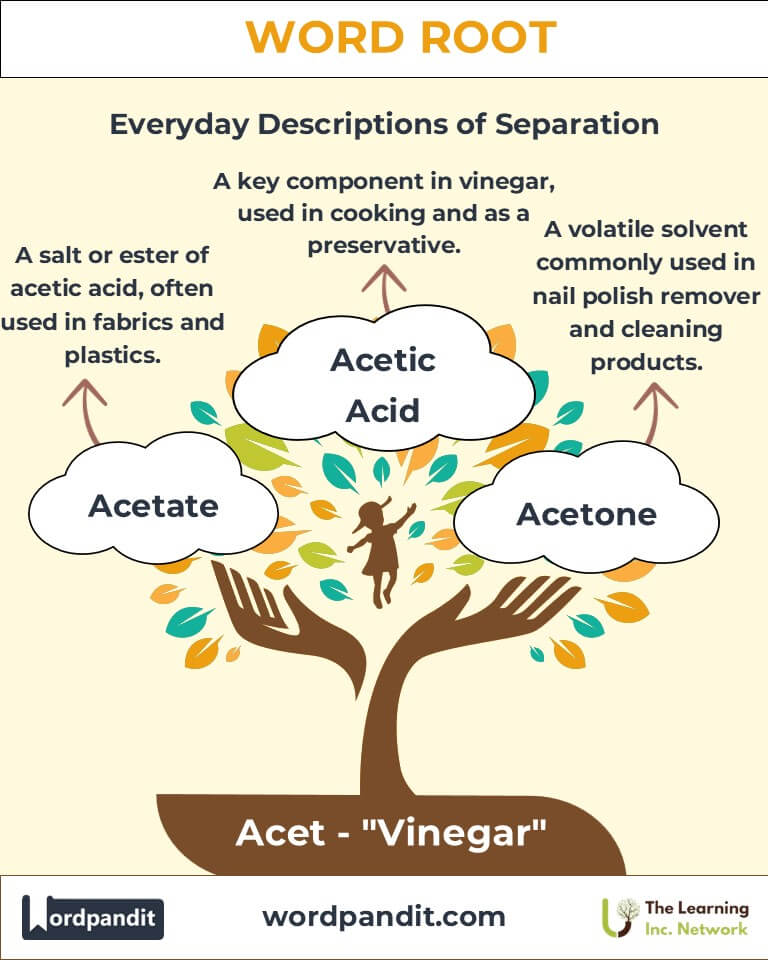Acet: The Root of Sour Chemistry and Scientific Discovery
Explore the fascinating world of the word root "acet," derived from the Latin word acetum, meaning "vinegar." This root has spiced up language and science alike, shaping words such as "acetic" and "acetone," which are central to culinary chemistry and industrial applications.

Table of Contents
- Introduction: The Sour Essence of "Acet"
- Etymology and Historical Journey
- Mnemonic: Remembering "Acet" with Ease
- Common "Acet"-Related Terms
- "Acet" Through Time
- "Acet" in Specialized Fields
- Illustrative Story: "Acet" in Action
- Cultural Significance of the "Acet" Root
- The "Acet" Family Tree
- FAQs about the "Acet" Word Root
- Test Your Knowledge: "Acet" Word Root Quiz
- Conclusion: The Lasting Legacy of "Acet"
1. Introduction: The Sour Essence of "Acet"
What’s the secret behind the tang of vinegar? The answer lies in the word root "acet." Derived from the Latin acetum (pronounced ah-set-um), meaning "vinegar," this root finds its way into scientific terminology and everyday language. Words like "acetic," referring to the acid in vinegar, and "acetone," a key ingredient in nail polish remover, showcase its impact across diverse fields.

2. Etymology and Historical Journey
The journey of "acet" begins with the Latin word acetum, representing sourness and tang. Its adoption into Old French as acetique and later into English brought this root into the scientific lexicon. In the 18th century, as chemistry advanced, "acet" became integral to naming organic compounds related to vinegar, solidifying its role in both language and science.
3. Mnemonic: Remembering "Acet" with Ease
Imagine a bubbling flask labeled "ACET," emitting the unmistakable sharp tang of vinegar. This sensory image ties the root to its meaning, helping you recall its connection to sourness and acidity.
Mnemonic Device: "Acet—where the tang of vinegar meets the science of chemistry."
4. Common "Acet"-Related Terms
- Acetic (uh-SEE-tik):
- Definition: Relating to acetic acid, a component of vinegar.
- Example: "The acetic acid in vinegar gives it its distinctive sour taste."
- Acetone (ASS-uh-tone):
- Definition: A solvent commonly used in cleaning and cosmetics.
- Example: "Acetone is the main ingredient in nail polish remover."
- Acetate (ASS-uh-tayt):
- Definition: A salt or ester of acetic acid, used in fibers and films.
- Example: "The acetate film proved to be an excellent medium for photography."
- Acetify (uh-SEE-tuh-fy):
- Definition: To turn into vinegar or acetic acid.
- Example: "Over time, the wine began to acetify, acquiring a sour flavor."
- Acetabulum (ass-uh-TAB-yoo-lum):
- Definition: The cup-shaped cavity in the hip bone, named for its resemblance to a vinegar cup.
- Example: "The acetabulum is a crucial part of the pelvic anatomy."
5. "Acet" Through Time
- Ancient Vinegar: In ancient Rome, vinegar (acetum) was not only a condiment but also a preservative and cleaning agent, showcasing its early versatility.
- Modern Chemistry: In the 19th century, the discovery of acetic acid’s role in fermentation cemented "acet" in the language of organic chemistry.
6. "Acet" in Specialized Fields
- Chemistry:
- Acetic Acid: Central to vinegar and industrial processes like plastics manufacturing.
- Medicine:
- Acetaminophen: A widely used pain reliever, derived from the "acet" root.
- Industry:
- Acetone: Used in manufacturing plastics, adhesives, and cleaning products.
- Biology:
- Acetylcholine: A neurotransmitter essential for muscle movement and brain function.
7. Illustrative Story: "Acet" in Action
In a bustling lab, Dr. Harper experimented with acetic acid to develop a new eco-friendly cleaning solution. Inspired by vinegar's natural properties, she combined acetone and other organic compounds. The result was a biodegradable cleaner that became a sensation, proving that the humble "acet" root could revolutionize sustainability.
8. Cultural Significance of the "Acet" Root
Vinegar, derived from the "acet" root, has played roles in rituals, medicine, and cooking across cultures. From ancient Roman soldiers drinking posca (a vinegar-based beverage) to modern culinary uses, "acet" embodies practicality and tradition.

9. The "Acet" Family Tree
- Acid (Latin: "sour, sharp"):
- Example: "Acidic," describing substances with low pH.
- Vinegar (Old English):
- Example: "Vinegar," derived from French vin aigre (sour wine).

10. FAQs About " Acet "
Q: What does "acet" mean, and where does it come from?
A: The root "acet" means "vinegar" or refers to sourness. It originates from the Latin word acetum, which literally translates to "vinegar." This root has found its way into many scientific and everyday terms, particularly those involving acidity or sharpness in taste and chemistry.
Q: How is "acet" used in science and medicine?
A: In science, "acet" appears in terms like "acetic acid," the primary component of vinegar, used in both culinary and industrial contexts. In medicine, the root is seen in "acetaminophen," a common pain reliever, and "acetylcholine," a neurotransmitter crucial for muscle movement and brain function.
Q: Is acetic acid the only derivative of the "acet" root?
A: No, acetic acid is just one of many derivatives. Other examples include "acetone," a solvent widely used in cleaning and cosmetics, and "acetate," which is important in materials like photographic films and textiles.
Q: What is the acetabulum, and why is it connected to "acet"?
A: The acetabulum is the cup-shaped socket in the hip bone that holds the head of the femur. Its name comes from the Latin word for a vinegar cup because the anatomical shape resembled the small vessels used for vinegar in ancient times.
Q: What role does "acet" play in everyday life?
A: "Acet" is central to vinegar’s culinary and preservative uses. Beyond the kitchen, "acet" derivatives are found in products like nail polish remover (acetone), medicines, and plastics, showing its widespread utility in daily and industrial applications.
11. Test Your Knowledge: " Acet " Mastery Quiz
1. What does the root "acet" signify?
2. What is the primary component of vinegar?
3. Which of the following is a neurotransmitter essential for muscle function?
4. What is acetone commonly used for?
5. Which term describes the process of turning wine into vinegar?
12. Conclusion: The Lasting Legacy of "Acet"
From its humble beginnings in vinegar to its pivotal role in science, the root "acet" bridges tradition and innovation. Whether enhancing flavors or advancing chemistry, it remains a testament to the enduring interplay between language and discovery.












